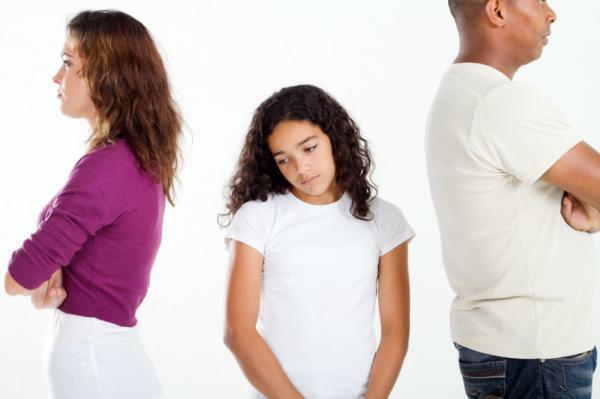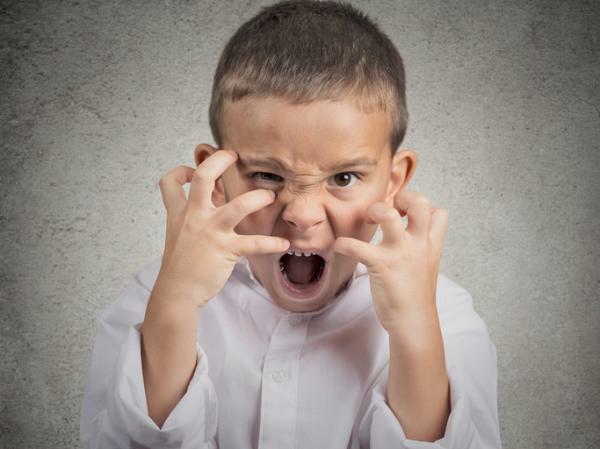
We could define the family as the union of people who share a vital project of existence that is supposed to last, in which strong feelings of belonging to said group are generated, in which there is a personal commitment among its members and intense relationships of intimacy, reciprocity and dependence.
However, relationships do not always end well, and many times both partners find it necessary to divorce for the common good. But... What about the children? In this Psychology-online article we talk about the family: divorce and children.
Index
- What is family: definition and implications of the concept
- Divorce: definition and types
- How to communicate parental separation to children
- The psychological impact of marital separation on children
- General lines of intervention
What is the family: definition and implications of the concept.
From the moment we are born, the family is constituted as the main support and support group. It begins with attachment behavior as soon as it is born, and ends with the possibility that the family offers us to access the resources that society offers us. In this sense, we can say that the family group fulfills a series of functions with respect to its children, which would be the following:
- Ensure their survival, their growth and their socialization in the basic behaviors of communication, dialogue and symbolization.
- Provide your children with a climate of affection and support without which healthy psychological development would not be possible.
- Give your children stimulation necessary to relate in a competent way with their physical and social environment, as well as the ability to respond to the demands and demands posed by their adaptation to the world that touches them to live.
- Take decisions regarding the opening towards other educational contexts that will share with the family the task of educating the child.

Divorce: definition and types.
It is in the sixties when one begins to have a rough estimate of the number of divorces both in Europe and in the United States. Since then and until now it is estimated that parental separations have grown by around 300% And, of course, the great victims of these decisions are usually children.
Divorce and children
Parental separation or divorce can be considered as a traumatic and stressful event for children and that, depending on the attitude shown by the parents towards it, can have consequences of one kind or another. By this we refer to the marital conflict that is usually present in the vast majority of marital separations and that it is a high risk factor in the development of psychopathologies in the childhood. However, it must be taken into account that this risk to which we are aiming depends, to a great extent, on the type of relationship and the number of conflicts that the marriage develops during the process; as well as the way in which parents communicate the decision to their children.
Types of divorce
The end of a marriage is a tough process, both for the couple and for the rest of the family, but here the children are the most vulnerable, since they see that concept of support group that the family represents and about which we have spoken in the introduction of the Article. All this is due to the great structural and personal change that a separation implies and as a consequence, according to Fernández Ros and Godoy Fernández, five types of divorce could be established with different consequences each one:
- Marital separation or psychic divorce: that supposes the emotional distancing between the couple, whether they are both in agreement or the decision is made unilaterally.
- Legal divorce: the one established by law and in which measures must be taken with respect to property, children, etc.
- Community or social divorce: that supposes the distancing of the members of the couple from the social environment that until then they shared.
- Property divorce: with regard to the distribution of goods that occurred in the couple
- Dependency Divorce: understanding as such an evident change of roles performed from here on.
These five types of divorce will have an impact on children, either directly or indirectly, taking into account the stages of crisis that their parents have to face and resolve them with respect to the post-divorce relationship between the members that make up the family.
How to communicate parental separation to children.
The process of communicating marital separation to your children is not an easy step. In the first place, you should never hesitate to make this decision and to inform the children of the obvious change that the family situation is going to undergo. Of course, it is very important for parents to make adaptations of their speech taking into account the age of their children: the information must be true but never aggressive to them. It is a big mistake to consider that hiding the reality of the separation from the little ones will benefit them in some case, as it usually only exacerbates confusion, insecurity, and mistrust of parents. Ideally, the children should be informed of the divorce decision with a margin of time before the non-custodial parent leaves the home (about two to three weeks), but the coexistence should not be lengthened either together much longer, since otherwise the children can interpret the situation as one of reconciliation or turning back.
The ideal climate
The ideal climate to proceed with the communication process would be a calm situation in which all members are present: Delegating responsibility for communicating the situation to one of the parents will only increase the degree of uncertainty and confusion in the little ones, since on rare occasions the versions of the couple tend to coincide one hundred percent broken. It is essential to make the children see that the decision has been made jointly and show them to them a fluid communication avoiding tensions, confrontations and, above all, disqualifications to the other. It is also essential that the little ones are clear that it is not in their hands to change this situation; emphasize that the decision is consensual and that there is no going back. No hopes should be left sheltered or open doors, the little ones have to start from minute zero to assume the new situation and face it in an optimal way.
Not giving details
Children should never be involved in the details of the breakup, especially if we are talking about young children. With giving a general explanation it will be enough, since otherwise we would cause a higher involvement in the little ones with respect to the causes of the separation and, therefore, greater emotional damage. In addition, it is necessary to make clear the type of relationships that are going to be broken (love, commitment conjugal) and that the filial and fraternal paternal bond will always exist no matter what happens with the marriage.
Let children express themselves
Once the news is given, it is essential to give the children some time to express what they feel and to answer your doubts or questions in the most affordable way possible. We must be understanding with the reactions they may have and, above all, that they perceive warmth and support to be able to express their fears and uncertainties with the new situation. From now on, the work of both parents will not be easy, since they must somehow find a balance when raising their children in the new reality: They should never show a victimizing attitude towards them or overprotect them in excess, although it is true that excessive uprooting and isolation will not be beneficial.
The psychological impact of marital separation on children.
The psychological impact that the parental separation decision can have on children depends on many factors, including age. Depending on the evolutionary age of the little ones, the ability to understand the situation will be different and, therefore, their reaction as well.
Preschool age
To date, the stage in which children are most vulnerable to this process is not clear, but numerous authors point to preschool age as the most critical, especially taking into account the level of moral and personal development of the little ones at this stage. It is precisely at this stage that children tend to present more symptoms of anxiety, fear of abandonment and self-blame. There are also evident alterations in the game and in the family concept, reflected in the artistic productions. We can also observe regressions in the child's behavior (thumb sucking, infantile speech, toilet training, etc).
School age
In the school stage the symptoms may be closer to the Depression than anxiety, although comorbidity is not ruled out in any case. Fears of abandonment can become evident, as well as obvious behavioral problems shown with both parents, behaviors that they have as purpose to manifest a reaction to the new reality that they have to live and that, in a certain way and within limits, should be allowed in the the beginning. It is important that children (at whatever stage) can express their emotions and frustrations before a decision that will affect them but is beyond their control.
Preadolescence and adolescence
Preadolescence and adolescence are stages of change at an emotional and psychological level in children, and that is why they can be considered complicated at the level of reactions and coping of the new situation. Anxiety, aggressiveness and even identity problems can occur; although, on the other hand, a withdrawal from the situation may occur taking the peer group as an axis of support. They are ages of vulnerability to depression and suicide feelings or attempts if they cannot empathize with the circumstances presented by the parents as motivators for divorce.

General lines of intervention.
The intervention proposed from the field of psychology to parental separations can be proposed from several areas of action:
- The child's age: in the first place, there is a susceptibility to perform an intervention in the face of emotional and psychological problems that are generated in children as a consequence of the new family reality. In this case, we would take into account what was commented in previous paragraphs regarding the age of the child and the symptoms that it presents in each case. During this process, the assistance and support of parents in all phases of treatment is essential, as well as other relevant family figures who can contribute something to it.
- Family presence: secondly, it is possible to proceed to an intervention in the family nucleus, if the reactions and behaviors that the child exhibits are affecting her relationship with one or both parents. In this case, the presence of all family members becomes essential and all would become identified patients in the process.
- Family mediationThird, and in more extreme cases, family mediation may be necessary. This resource is considered necessary when there are serious conflicts between the dissolved couple, which make up a climate of continuous hostility that makes a cordial relationship impossible when dealing with issues related to children. That is why it is considered an intervention based primarily on conflict management, taking as a figure mediator to a psychologist who will help both parties to bring positions closer together and to seek and prioritize the welfare of the little ones.

This article is merely informative, in Psychology-Online we do not have the power to make a diagnosis or recommend a treatment. We invite you to go to a psychologist to treat your particular case.
If you want to read more articles similar to The family: divorce and children, we recommend that you enter our category of Family problems.
Bibliography
- Feliu Pi de la Serra, M.H. (2000). Ending Well: How to Cope with Separation and Divorce. Ed. Martínez Roca.
- Fernández Ros, E. and Godoy Fernández, C. (2005). The child before the divorce. Ed. Pyramid.
- Martín Calrero, V. and Fernández Hernández, E. (2005). Separated parents with young children: overcoming the conflict. Ed. Teleno.
- Pussin, Gérard and Martin, Elisabeth (2005). Children of Divorce: Child Psychology and Parental Separation. Ed. Mad.


